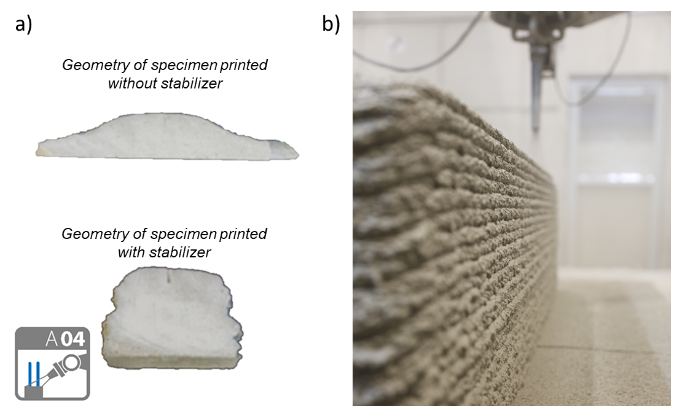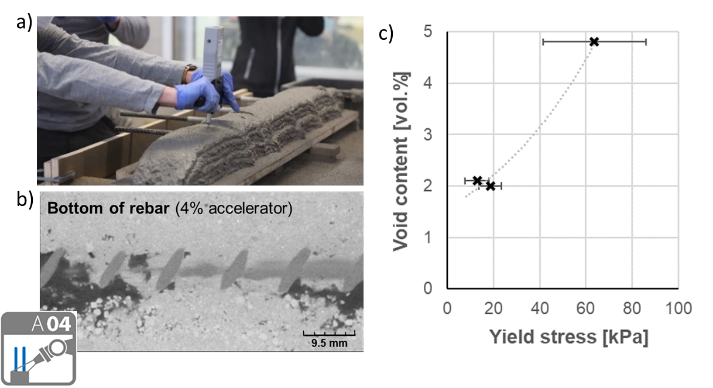Research Summary Report A04
Integrated Additive Manufacturing Processes for Reinforced Shotcrete 3D Printing (SC3DP) Elements with Precise Surface Quality
[18.03.2022]
Freund, Niklas; doctoral researcher, n.freund@ibmb.tu-bs.de
Vandenberg, Aileen; postdoctoral researcher, a.vandenberg@tu-bs.de
Lowke, Dirk; project leader, d.lowke@ibmb.tu-bs.de
all: TU Braunschweig, Institute of Building Materials and Concrete Construction and Fire Safety (iBMB)
Project A04 aims to investigate cooperative Additive Manufacturing (AM) processes based on Shotcrete 3D Printing (SC3DP) for the production of material-efficient, force-optimized, reinforced, load-bearing concrete components with precise surface quality and geometry precision. The goal is to produce large-scale concrete elements using significantly lower amounts of reinforcement and concrete as compared to standard concrete construction principles.
Summary
Within SC3DP, concrete has a duality to the special requirements that are placed on it. On one hand, the concrete needs to have good workability as it is pumped through the hose from the concrete mixer to the printing nozzle. On the other hand, after leaving the nozzle, the concrete has to show sufficiently high enough structural build-up to maintain dimensional stability against gravitational forces and the ability to bear loads of the layers placed on top of it, but not too sufficiently high so that a good bond between the applied layers can be achieved.
By rheological characterization of the used materials and the preparation of specimens with SC3DP, the effects of the concrete composition and the material-process interactions (e.g. by the air volume flow or the nozzle-to-strand-distance, etc.) on the resulting strand geometry as well as structural build-up can be investigated.
It can be shown that the use of different types of additives (e.g. set accelerators and stabilizers) has a significant effect on the resulting strand geometry. Figure 1 shows an example of the effect of stabilizer on the resulting specimen geometry. It can be seen that in this case, without a stabilizer, the applied layers can not hold the gravitational force, as well as the load of the layers, applied on top of it. By using a stabilizer (Fig 1a, bottom), layers with a significantly higher dimensional stability are obtained.
With a properly adjusted concrete mix design, layers with defined geometry can be produced within the SC3DP process to manufacture large-scale concrete components (see Figure 1b).
Current state of research
In addition to the effects on the resulting strand geometry and the buildability of the applied layers, the rheological fresh concrete properties also play an essential role in the integration of reinforcement elements. In contrast to a conventional production of reinforced elements in molds, 3D-printed concrete is not externally compacted after production. Thus, the bond quality to integrated reinforcement elements depends significantly on the rheological fresh concrete properties. For the reinforcement strategy of “interlayer reinforcement bars”, where reinforcement bars are placed in the interfaces between deposited layers, Freund & Lowke (2022) found that an increasing yield stress of the applied material is accompanied by an increase of voids around the integrated rebars. Here, a direct correlation to the resulting mechanical bond strength was found. Freund & Lowke (2022) systematically increased the yield stress of the applied concrete by adding set-accelerator. The yield stress was determined in-situ using a shotcrete penetrometer, see Figure 2a. The void content could be determined by computed tomography, see Figure 2b. Figure 2c shows the relationship between yield stress and the determined void content in the surroundings of the integrated rebar.











